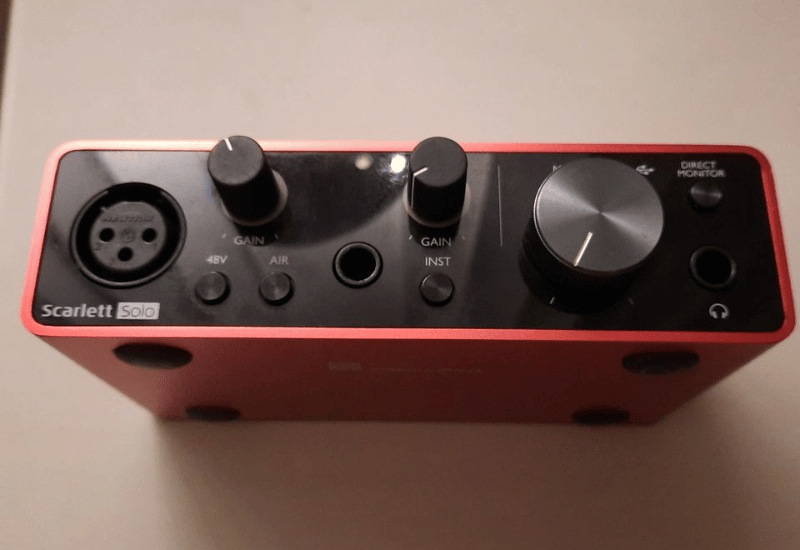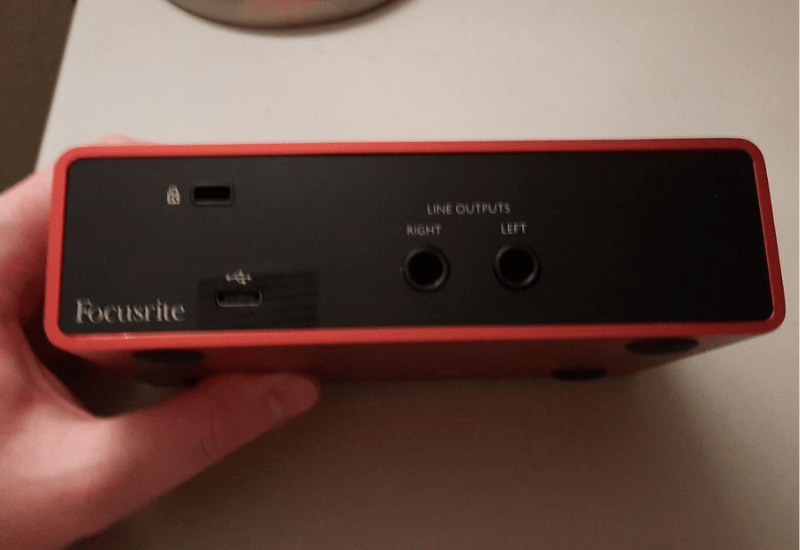The Focusrite Scarlett 2i2 (4th Gen) marks a significant milestone in home recording technology. This compact and versatile USB audio interface has gained widespread acclaim for its blend of simplicity and exceptional quality. It’s designed for a diverse range of users, from novices to experienced professionals, making it a perfect choice for singer-songwriters, podcast creators, and home studio enthusiasts.
Design and Build
The design of the Scarlett 2i2 is a perfect blend of aesthetics and functionality. It features an eye-catching red metal chassis that is not only visually appealing but also robust, ensuring longevity and durability. Its compact size is ideal for small studio spaces or mobile recording setups.

The front panel is thoughtfully laid out, with two combination inputs that can handle both XLR and 1/4″ connections. These inputs are powered by Focusrite’s renowned preamps, known for delivering pristine audio quality. The intuitive front panel design includes gain controls for each input, a direct monitor switch, and a prominent monitor volume knob, making adjustments straightforward and efficient.
Performance
The Scarlett 2i2 stands out for its sound quality. The preamps provide a clean, low-noise signal that is essential for high-quality recordings. They offer a balanced mix of clarity and warmth, ensuring recordings sound natural and detailed.
The 4th Gen model has improved headroom, allowing for better handling of high-output pickups. This means it can accommodate a wider range of instruments without risking distortion or clipping. With 24-bit/192kHz AD-DA converters, the 2i2 ensures high-fidelity recording and playback, capturing every nuance of the performance with precision.
Features
The Scarlett 2i2 is packed with features that enhance its performance. The Air Mode, inspired by the classic Focusrite ISA preamps, adds brightness and presence to recordings, particularly benefiting vocals and acoustic instruments.
The interface offers incredibly low latency, crucial for efficient recording and monitoring. This low latency ensures a seamless experience for performers, allowing them to hear themselves in real-time without delay.
The Scarlett 2i2 also comes with a generous software bundle, including Ableton Live Lite, Pro Tools First Focusrite Creative Pack, and various plug-ins and samples. This comprehensive package provides users with a wide array of creative tools right from the start.
Usability
User-friendliness is a key aspect of the Scarlett 2i2’s design. The interface’s plug-and-play setup means users can start recording with minimal fuss. Most operating systems recognize the device without needing additional drivers.
The direct monitoring feature is particularly valuable for vocalists and instrumentalists, enabling real-time, latency-free feedback. The LED halo meters around the gain knobs provide immediate visual feedback on input levels, helping to manage the signal and avoid clipping.
Connectivity
The Scarlett 2i2 uses a USB-C connection for fast and reliable data transfer, compatible with a wide range of modern devices. Being bus-powered, the interface doesn’t require an external power supply, enhancing its portability and making it ideal for mobile recording setups.

Limitations
Despite its numerous strengths, the Scarlett 2i2 has some limitations. It is not suited for recording large ensembles or complex multi-microphone setups due to its two inputs. Additionally, the lack of MIDI connectivity might be a limitation for those looking to integrate MIDI instruments or controllers into their workflow.
Focusrite Scarlett 2i2 (4th Gen) vs. Previous Generations
The Focusrite Scarlett 2i2 has evolved significantly over its generations, each iteration bringing notable improvements. Let’s compare the 4th Gen with its predecessors to highlight these advancements.
1st Gen to 2nd Gen
- Preamps and Sound Quality: The 2nd Gen introduced upgraded preamps, offering a more transparent and detailed sound. This was a significant step up from the 1st Gen, which, while solid, had slightly more colored preamps.
- Latency: The 2nd Gen boasted lower latency compared to the 1st Gen, making recording and real-time monitoring more efficient.
- Design: There was a noticeable design overhaul from the 1st to the 2nd Gen, with the 2nd Gen featuring a more robust and sleeker design.
2nd Gen to 3rd Gen
- Air Mode: The 3rd Gen introduced the ‘Air’ mode, emulating the classic ISA preamps, adding clarity and presence to the recordings — a feature not present in the 2nd Gen.
- USB-C Connectivity: The 3rd Gen switched from USB 2.0 to USB-C, allowing for faster and more reliable data transfer.
- Improved Headroom: The 3rd Gen provided better headroom for recording loud sources, which was a step up from the 2nd Gen.
3rd Gen to 4th Gen
- Sound Quality Enhancements: The 4th Gen further refined audio quality, offering even cleaner and more detailed recordings.
- Latency Reduction: Continuing the trend, the 4th Gen further reduced latency, making the recording experience even smoother.
- Additional Software: The 4th Gen expanded its bundled software, offering a wider range of tools and plugins for users.
From the 1st to the 4th Gen, the Scarlett 2i2 has seen improvements in preamp quality, design robustness, connectivity options, and additional features like the ‘Air’ mode. Each generation has built upon the last, offering clearer sound quality, lower latency, and more user-friendly features.
Wrapping Up
The Focusrite Scarlett 2i2 (4th Gen) is an excellent choice in the home recording interface market. It effectively balances sound quality, ease of use, and build quality in an affordable package. This interface is especially well-suited for a broad range of audio recording needs, from simple vocal tracks to more elaborate instrument recordings.